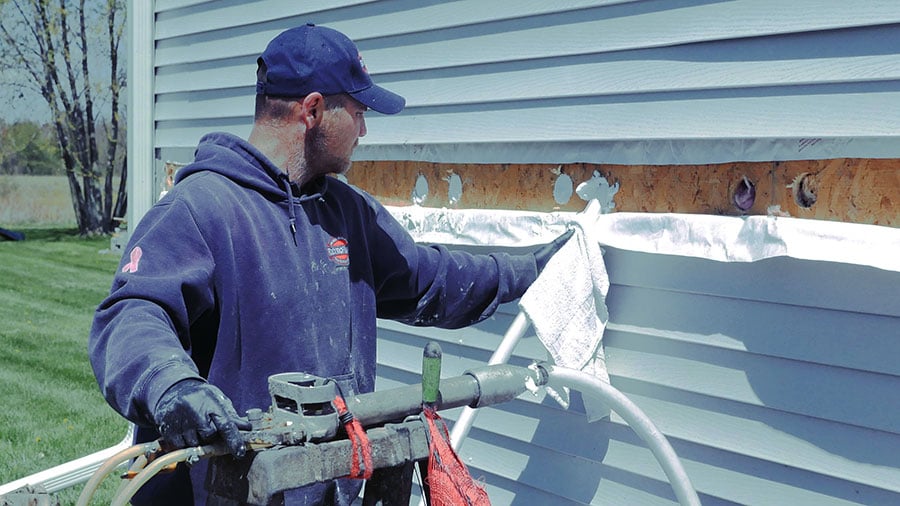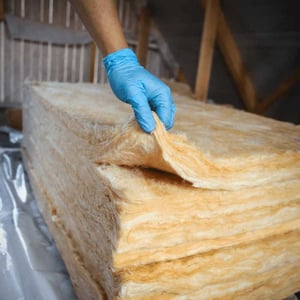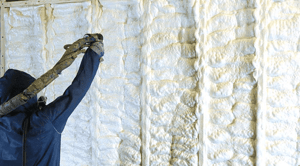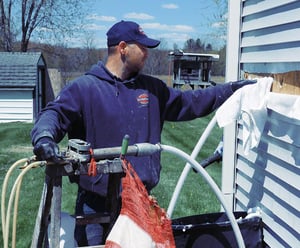What is the Best Insulation for Exterior Walls?


Wall insulation is an important staple in your home.
It prevents cold drafts, uncomfortable rooms, condensation issues in the wall, just to name a few of the things a good insulation can help to prevent.
Whether you’re building the home of your dreams, remodeling your current home, or you just feel like the insulation you have now isn’t cutting it, you’re on the hunt to find the best exterior wall insulation.
In existing homes and new build homes, here at RetroFoam of Michigan we have helped thousands of homeowners in your situation. We can help your new or existing home meet your expectations with foam insulation.
Just because foam is all we do, doesn’t mean that in this article we aren’t going to go through each insulation option to help you determine which will be best for your exterior walls.
Exterior Wall Insulation Options for New Build Homes or Remodeling Projects
If you’re in the process of building your new home or your current home is in the process of a remodel and gutted, you have options because those cavities are open.
Don’t worry, if this isn’t the case for you and your walls are still intact, we’ll get into how that is done shortly.
Now if your exterior wall cavities are open and exposed, here are the insulation options you have available.
Fiberglass Insulation
 Fiberglass is an insulation material made up of extremely fine glass fibers.
Fiberglass is an insulation material made up of extremely fine glass fibers.
The material is most commonly found in homes as either batts or loose fill. Fiberglass is also sold as rigid boards and as duct insulation.
As an insulator, fiberglass works to slow the spread of heat, cold, and sound in structures. It does this by trapping pockets of air.
Foam Board Insulation
Foam board insulation are rigid panels of insulation that are made of either polystyrene, polyisocyanurate, or polyurethane.
To ensure the material can be customized for your project, the rigid foam boards are sold in a variety of thicknesses, lengths, and facings. There are some foam board insulations offered on the market that include a white foil vapor barrier on each side to prevent water from moving through it.
Foam board creates a good thermal resistance and reduced heat conduction through parts of the home like wood and steel studs.
Wet Applied Cellulose Insulation
Cellulose insulation comes in many forms, but when it comes to open wall cavities wet applied cellulose is what will be used.
Cellulose is the oldest home insulation available on the market today. It is made from recycled newspapers and the small particles are good at conforming to most spaces.
Wet applied cellulose has water added to it during the application process. It has the same thermal and sound dampening properties as dense packed cellulose.
Nu-Wool Insulation
Nu-Wool is known to be a premium cellulose insulation that is either wet applied or installed in batts.
The Nu-Wool batts are used in new construction or remodeling projects when the walls are exposed. The batts are made of 70 percent recycled materials and a mixture of renewable fibers. The rolls and batts are made to create a tight fit in the wall cavity and are very dense.
The density of the batts help deaden sound in the home.
Foil Faced Insulation
Foil faced insulation works great to prevent heat transfer into or out of the home depending on the time of year.
The foil faced insulation is usually made of fiberglass batts. The foil on the insulation is designed to help reduce heat loss and also works as a vapor retarder.
Flash and Batt Insulation
Flash and batt insulation is a hybrid of closed cell spray foam coupled with fiberglass.
It is a technique where 1- to 2- inches of closed cell spray foam is applied to the wall cavity in an effort to create an air seal with a fiberglass batt placed over top of it for added R-Value.
It’s important to note here that an air seal is what you most definitely want in your home, but to achieve it with closed cell you need a minimum of 2- to 3-inches depending on the manufacturer.
Open Cell Spray Foam Insulation
 Open cell spray foam is an insulation material that creates a continuous insulation and air seal wherever it is applied.
Open cell spray foam is an insulation material that creates a continuous insulation and air seal wherever it is applied.
The air seal created by open cell spray foam is known to help homeowners maintain a constant temperature no matter the time of year due to the air seal it creates.
Open cell spray foam is a water blown spray insulation that is made of a polyisocyanurate and a resin. These components are kept separate until it’s time for the material to be installed, so the mixing takes places at the job site.
Which is the Best Insulation for Walls
Out of all of the options you read about above, you’re looking for the best insulation for exterior walls, so which ones make the cut?
The best insulation for walls when it comes to new build homes or remodels is going to be Nu-Wool, foam board, or open cell spray foam.
Let’s take a deeper dive into each of these materials and what makes them the best.
Nu-Wool Insulation
Nu-Wool insulation is a cellulose material, but has some differences in its pros and cons.
Pros:
- Nu-Wool is durable and lasts longer than wet applied cellulose.
- It has a higher R-Value than fiberglass batts.
- Nu-Wool cellulose batt insulation is made of 100 percent recyclable and renewable materials.
- This material can be installed as a DIY project without the need for any special equipment.
Cons:
- Nu-Wool doesn’t create an air seal by itself, so you would have to take extra measures to create one.
- This insulation is not the most thermal resistant.
- Like any other cellulose material, pests and rodents are known to make nests in it.
- Nu-Wool can be a DIY project, but it’s not as readily available as other DIY options.
Foam Board Insulation
Knowing the pros and cons of foam board insulation can help you make your decision for what will be best for your home.
Pros:
- Foam board is made to be water resistant which is helpful in limiting the amount of moisture buildup inside your home. This will also reduce the chance of mold growth.
- If you’re looking for the cheaper option, expanded polystyrene board is the cheapest foam board insulation available.
- Depending on your handiness prowess, the installation of foam board can be done as a DIY project.
Cons:
- To prevent airflow into your home, the seams between the foam board must be taped or caulked.
- Foam board must be custom cut to fit the studs where it is being installed or you will experience air leakage.
- Expanded polystyrene boards have air bubbles in them that can stop heat transfer, but also collect moisture. This moisture will make the material ineffective at preventing mold and mildew.
- Polyisocyanurate foam boards lose insulating capabilities over time, which means they would need to be replaced at some point in the future.
Open Cell Spray Foam
Open cell spray foam can outperforms traditional insulation, but let’s take a look at the material’s pros and cons.
Pros:
- Open cell spray foam has the added benefit of sound deadening in the home.
- As a new home shifts and settles, the pliable open cell with move with the structure.
- Unlike traditional insulation, open cell spray foam does not promote the growth of mold and mildew.
- Creates an air seal where it is sprayed to make the home more comfortable and energy efficient.
- If there were ever a need to replace electrical wiring, the foam is pliable enough to fish wiring through.
Cons:
- Open cell spray foam is an expensive option for insulation.
- Spray foam can’t be installed as a DIY project.
- Some brands of spray foam have an odor when installed.
What if the Exterior Wall Insulation Needs to Be Updated Down the Road?
 What are your options if the walls of your existing home are enclosed? Will you have to tear down your drywall just to update your current insulation?
What are your options if the walls of your existing home are enclosed? Will you have to tear down your drywall just to update your current insulation?
Don’t worry, friends. You have insulation options that won’t require any kind of demolition or disruption of the inside of you home. As a matter of fact, you have two options that can be done from the outside – blown-in cellulose and injection foam insulation.
The process for both of these materials is the same but can vary depending on the type of siding your home has.
If the home has vinyl or aluminum siding, a row of siding is removed, and a hole is drilled into each stud cavity. The insulation is then injected or blown-in to the cavity until it is full. The hole is then plugged, and the siding is replaced.
A home with brick siding has a different process with three holes being drilled into the mortar where each stud cavity is. The insulation is then injected in the top, middle, and bottom of the cavity. A good contractor will re-mortar those drilled holes.
Lastly, if the home has wood siding the process will depend on the condition of the wood. If the wood can be removed, then it is treated similarly to vinyl or aluminum siding. If not, then the crews will need to drill through the wood to inject or blow-in the insulation. Once the wall cavities are full, the holes are filled with a tapered pine wood plug.
The best insulation impacts the conduction – heat transfer – and the convection – airflow – which can both impact the comfort of your home, as well as the energy efficiency.
While cellulose is resistant to heat that is transferred through conduction, it doesn’t create an air seal that will keep the air you pay to treat inside and the outside air out, as it still allows for air movement.
To reduce air leakage, foam insulation works best because it provides heat resistance and an air seal.
Choosing the Best Insulation for Outside Walls
Now that all of the options have been laid out before you, all you have to do is choose.
We discussed which options are best for your new build home, remodeling project, and existing home. Now it just comes down to your budget and expectations.
If you’re looking for that air seal and energy efficiency we talked so much about, then foam is going to be the best option for you to achieve the comfort and low monthly energy bills you want.
If cost is more of an issue for you, then you might go with one of the less expensive options. It all comes down to what works best for you and your dream home.
Related Articles
Installing RetroFoam into Exterior Walls with Different Siding Types
5 Areas Not to Skimp on When Building a New Home
About Amanda Ringler
Amanda previously has worked as a breaking news and crime reporter, TV news producer, and editor in Flint and Detroit. Throughout her career as a journalist, she has won several awards from The Society of Professional Journalists - Detroit Chapter and the Michigan Press Association. As part of the RetroFoam of Michigan family, Amanda uses her experience as a journalist to write content that will help educate homeowners on the benefits of foam insulation. When Amanda isn’t writing, she’s spending time with her husband and rescued huskies. She also loves knitting, making art, cooking, and hosting dinner and a movie night for friends and family.

.jpg)

